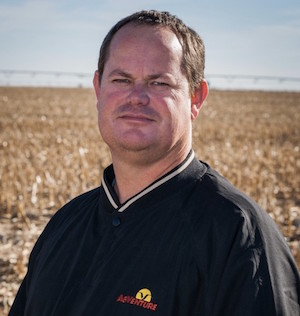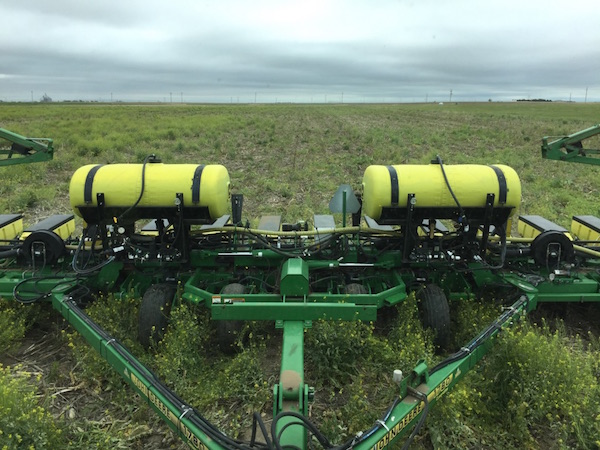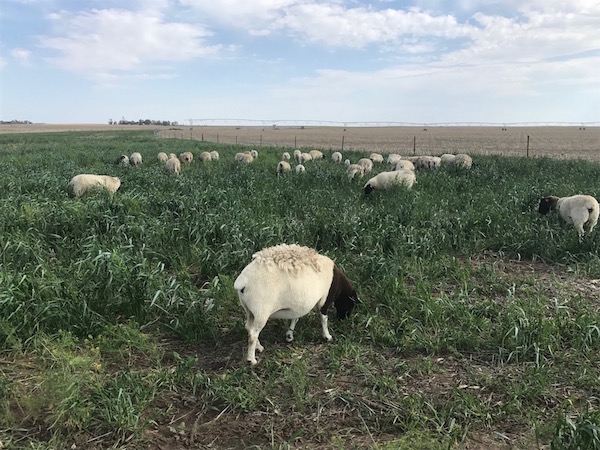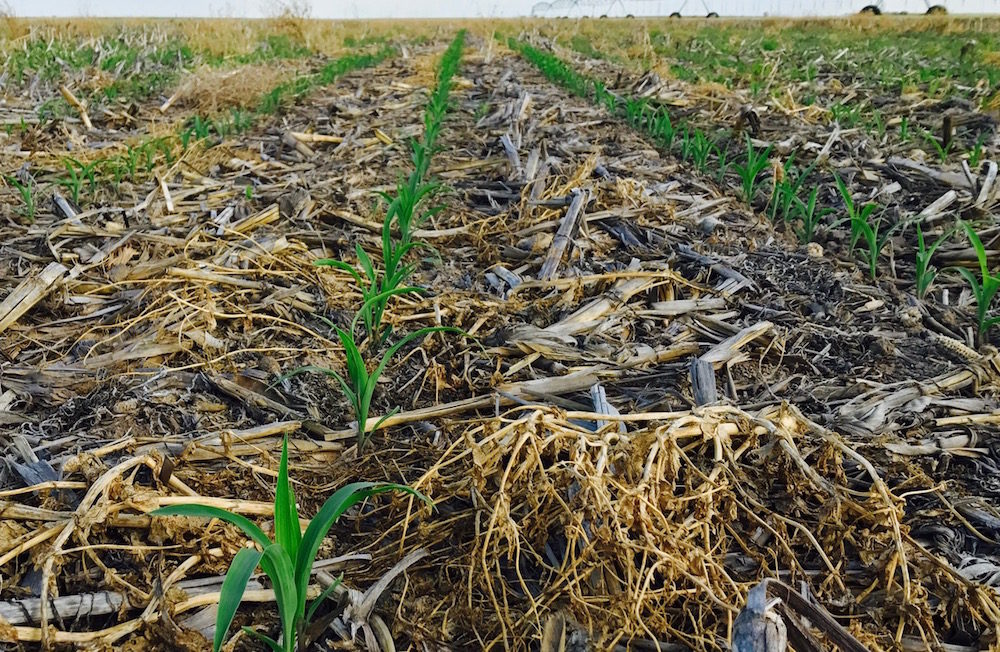Pictured Above: May-planted no-till corn emerges through a layer of cover crop residue on Nick Vos’ farm near Hugoton, Kan. Vos no-tills corn 2-3 inches deep to promote maximum root structure that allows plants to have five sets of nodal roots to help corn in times of stress.
When Nick Vos came from South Africa to the U.S. to farm, the transition wasn’t an easy one.
He grew up on a vegetable farm in the Limpopo Province of South Africa, North of Johannesburg. Their family lost everything in 2000 during a massive flood following 23 inches of rain falling in just over one week.
Every bridge along a 168-mile-long river in his area were taken out and the Vos family’s crops were without power for over 2 months. What didn’t flood, dried out and died.
Vos had the opportunity to move to the U.S. as a green card holder in 2006 and began farming with another enterprise. Vos’ family became U.S. citizens 5 years later. In 2014 Vos started to farm on his own. He no-tills various dryland and irrigated crops and raises sheep near Hugoton in southwestern Kansas. That same year he also started Prairie Seeds, selling seed corn and cover crop seed.

Nick Vos
Starting Off
He started off strip-tilling newly acquired fields in 2014 to break through hardpans. Most fields he picked up were conventionally tilled for a decade or more and had some hardpan issues, erosion and tons of bindweed.
“We had 180 acres of irrigated ground we picked up that was in conventional tillage and had bindweed in it all the way up to tassel in our first corn crop,” he says. “The fields weren’t in good shape.”
He’s since gone to 100% no-till where possible, except for 200 acres of fallow he was forced to pass over with a sweep plow to control weed problems after a wet May. But through converting ground to no-till Vos says he’s addressed the erosion and nutrient issues and seeing some relief in irrigation costs.
Vos estimates no-till saves him an average of 4 inches per year in water needed for his irrigated crops, a savings of $40 an acre. This is key in a semi-arid climate. As of March 16, Vos’ area had gone 160 days without any measurable precipitation.
Smarter Seeding, Fertility
Vos farms about 1,000 acres, 300 irrigated and 700 dryland, no-tilling all corn, soybeans, milo and wheat where possible, as well as oats for hay. His wife Johanna started incorporating Dorper sheep into the operation 3 years ago.
For planting milo and corn, Vos uses a John Deere 1780 23/15 split planter, with a wavy coulter, no row cleaners and steel closing wheels. The machine has a SheildAG/Acra-Plant system and Raven 4400 rate controller to apply fertilizer in furrow with the 12-row planter.
His 15-foot CrustBuster drill, set to 10-inch spacings, has Schaffert Mfg. fertilizer tubes and a Raven controller.
With those tools at hand, here are some keys Vos shared at the No-till on the Plains Winter Conference about how he no-tills crops in a semi-arid region:
Know it Cold. One of the keys to making corn work, Vos says, is knowing the cold germination score of corn seed. He often plants in April when soils are 50-55 F, not 70 F, which is usually what the germ rate on the bag is measured at.
Since working with Agventure, Vos likes to plant corn deeper — 2-3 inches — to promote maximum root structure and allow plants to have five sets of nodal roots. Planting corn less than 2 inches could reduce the chance of forming the fifth set, reducing root systems by 20-30%, he says.
“This does not help the corn in stress times,” Vos says, noting that he learned about the root-structure issue from a friend, Glen Long.
Vos plants soybeans about 2-2 ½ inches deep, about 1-1½ inches deeper than the norm.
Take Your Time. “Plant slower,” Vos says. “Tests at research farms shows singulation almost never adds yield, but even emergence always does. Getting all the corn to germinate at the same time is vital to have good yield.”
Split it Up. Given the volatile weather conditions in his area, and the low organic matter in his soils, Vos feels it’s best to use multiple applications of nitrogen (N) rather than applying it all at once like many of his fellow farmers do.
“We advise people never put all your eggs in one basket with N. Then if you get a hailstorm, you don’t have a lot of inputs in there,” he says.
Vos says fertigating corn through pivot irrigation is important, but he also applies 2½ gallons of 10-34-0 starter fertilizer in-furrow, blended with Royal Grow’s Enzyme Max and Micropack, noting that it’s important to put a carbon source with the fertilizer. That’s followed later with a foliar application of Micropack that includes manganese with his post-emergence herbicide application.
“For corn we do tissue sampling at V5, V10 and at tassel, trying to correct any deficiencies at V5, V10 with foliar products. At tassel we mostly check to get an idea of the fruit set and where we’re going to be next year,” he says. “What did we miss? If we miss something we can’t usually correct it at tassel, but it gives us an idea for next year on what we need to do.”
Vos consults with his nephew Willem Pretorius, an agronomist in Goodwell, Okla., on the tissue test results as well.
He follows a similar program for double-crop soybeans, aiming to apply 1 pound of phosphorus (P) for every 1 bushel of soybeans anticipated. He is hoping to use less as his soil’s biology increases.
Vos also double-inoculates soybeans, especially in soils where he’s never planted the crop before, utilizing a seed treatment and then applying a dry product at planting. He says trials on his farm have shown the program works just as well or better than university-recommended practices of applying N through a pivot.
He rarely adds extra N to the soybean crop unless he expects yields of 80 bushels or more. Even then he still prefers a foliar instead.
Narrower Beans. Early on, they strip-tilled soybeans in 30-inch rows. He didn’t feel humidity levels in the canopy were high enough, so he started doing trials with soybeans drilled in 10-inch spacing and they out-yielded beans in 30-inch rows right away, he says.
“I can honestly say that in my area, 10-inch beans have become the norm,” Vos says. “We’re so dry and arid that in 30-inch beans you’ve got too much airflow through the canopy. With 10-inch beans you stop the airflow, you create a little greenhouse effect and it adds yield.”
Low-Budget Wheat. Vos says he’s been farming in the U.S. for more than a decade and winter wheat has yet to be a dependable crop, but it’s still important to his rotation.
“We spend as little money as possible on wheat and wait and see what happens,” he says. “It’s an excellent cover crop and weed suppressor. A lot of guys use wheat over the winter to cover their fields.”
For the last 5 years Vos has been including about 2 pounds of Daikon radish for every acre of seeded wheat, and clover has been added recently. While he hasn’t seen much of a yield bump, Vos feels his own trials show wheat handles drought and heat stress way better when cover crops are present.
While milo is a good high-carbon crop and can be useful for grazing stockers and increasingly cow-calf pairs, Vos says he’s struggled with controlling Palmer amaranth, bindweed and grass weeds in the crop. It also doesn’t handle high-pH soils well.
Covers in the Dust Bowl
Vos started seeding cover crops in 2010 when he was still part of the other farming operation, and he’s continued working with covers since then.

Nick Vos uses a John Deere 1780 23/15 split planter with a wavy coulter, no row cleaners and steel closing wheels to plant corn and milo, along with a SheildAG/Acra-Plant system and Raven 4400 rate controller to apply fertilizer in furrow. During this May corn planting Vos notes the lack of pigweeds and kochia in the field due to the presence of cover crops over the winter.
His main opportunities to seed covers are behind winter wheat, flying them on into standing corn, drilled in before or after corn or soybeans, or drilled after milo for grazing.
Vos has embraced Daikon radish for its ability to scavenge nutrients in his sandy, low organic-matter fields, noting it has produced good results on his farm because they help neutralize his high-pH caliche soils. Caliche soils are layer-like accumulations of calcium carbonate.
Brassicas like mustards, radishes, broccoli and kale don’t associate with mycorrhizae, but use acids to get minerals for themselves, rhizosphere ecologist Jill Clapperton has said. The acid exudates free up P being tied up by calcium and help in mineralizing bound-up P.
Brassicas also stimulate the middle of the food web that includes mites, earthworms and other recyclers that prey on bacteria and fungi.
“When you take a pH from 8.8 down to 7.5 or 7 in the root zone you’ll have a lot more nutrients available for the next crop. That’s why we've been seeing the yield bump we’re getting with corn,” Vos says. “We have not put phosphorus in our corn field 2 years in a row now, this year will be the third. The only phosphorus goes with the starter in the root zone with 10-34-0. We are doing tissue sampling continuously and we’re not deficient in phosphorus yet. The soil biology seems to work for us.”
Vos considers the “most valuable cover” on his farm to be millets, brassicas and summer legumes drilled in after winter wheat harvest. The mix is best suited for sandy, irrigated fields.
There have been challenges as well with establishment and germination. Vos drilled cereal rye behind milo last October and the seed was still laying there dormant in late January.
Vos also isn’t having much luck seeding cereal rye after harvested soybeans. “Maybe it’s the late harvest or because of the lack of moisture. Soybean stubble always seem to be drier in fall than cornstalks,” he says.
“In the fall, as dry as we are, sometimes going with the calendar doesn’t work. So we’ve got to be opportunistic. It's still easier to drill it behind the milo and wait for it to sprout in November than trying to get something established in March.”
Vos hasn’t found his area very conducive to cover crop learning, either. Many farmers worry cover crops will use up too much soil moisture ahead of cash crops, so they stick with summer fallow.
Although federal agencies in 2012 loosened some of the restrictions on cover crop termination guidelines on fields covered by crop insurance, Vos says the local Risk Management Authority (RMA) offices have prohibited cover crop seeding in fallowed fields going to winter wheat. Fields full of pigweed, bindweed or simply sitting bare and eroding are still being deemed eligible for crop insurance by the RMA, Vos notes, but certain cover-cropped fields may not be.
When the right cover crop is seeded in the right situation, Vos says evidence seems to contradict what the RMA is saying. He’s seen data showing anywhere from 30-80% of soil moisture being lost from fallowed fields through evaporation.
“On a wheat-fallow field, if you have moisture probes in the cover crop next to the wheat stubble and probes in the wheat stubble, side-by-side, the cover crops will always draw moisture in during the summer and fall,” he says. “And the recharge in the fall, spring or winter is always quicker and higher in the cover crop mix.
“Long term, if we keep our ground covered and soil biology going, we’ve seen the plant growth be worth a lot more, in some cases, than the moisture.”
The Right Species
Additionally, Vos feels some of the yield drags or cover-crop failures in semi-arid areas are due to growers or researchers using species that isn’t well suited to their crop rotation, such as adding a high-carbon cover crop that uses a little too much N and moisture.
Because moisture is the limiting factor in his area in breaking down residue and recycling nutrients, Vos says he’s started using more low-carbon brassicas and legumes with corn.
“You don’t have a yield drag when you do it right,” he says. “Cover crops aren’t a magic deal where you just throw them out there and suddenly you start getting better results. It doesn’t work that way. It’s a planned crop just like a cash crop.
“Take your time. Find out what works in the area. Don’t talk to people that have done it that tell you it doesn’t work, because obviously they haven’t done it right.”
Vos also disagrees with experts who insist massive multi-species cover-crop mixes must be seeded to provide adequate benefits.
“Are we doing this for a purpose, or are we doing it to be cool? Or so we can tell our neighbors, ‘I’ve got more species in my mix than yours.’ Do what your soil can handle. If you have a 4% organic-matter soil, obviously you’ve got a lot more to work with then you have 0.8% organic matter.
“Do you need a low-carbon or a high-carbon cover? Be goal specific and know why you're doing what you're doing.”
Animal Action
Another facet of Vos’ operation is the Dorper sheep they raise for the “all-natural” meat market in Texas. Dorpers are a hair sheep breed that are acclimated to harsh arid environments, so they fit nicely in the local climate.

Dorper sheep graze in spring on a winter cover-crop mix near Nick and Johanna’s no-till operation near Hugoton, Kan. Grazing the animals — which are raised for the “all-natural” beef market — on cover crops provides increased nutritional value for the sheep, Nick says. Sainfoin and chicory added to some of the mixes prevents parasite issues in their herds.
Vos and Johanna run about 200 head on 22 acres of grass and cover crops. If all goes well, they may take their dryland acres out of cash grain production this year to expand the herd significantly. “Half the reason we’re converting these acres is due to the high chemical costs in a fallow year that aren’t sustainable,” he says.
The meat-focused, balanced-fat animals are raised on cover crops and pasture without antibiotics. They’re fast growers and not highly dependent on carbohydrates.
“If we do use an antibiotic with one, the tag number gets written down and the animal goes to a separate pen and we’ll feed it out ourselves,” he says. “We have customers that don’t care about it.”
Vos plants oats in March ahead of corn or soybeans to both stimulate soil biology and provide hay for the sheep. They also fed the sheep baled milo stalks last year due to the drought, but Vos prefers they feed on cover crops when they’re established.
"The more beneficial species we can get into those cover-crop mixes, the more we can add health to the animals."
— Nick Vos
Persistent dryness makes establishing the oats or cover crops difficult some years. He’s had oats seeded in March not emerge until May at times. He’s also had problems finding articles or studies with guidelines on grazing sheep on cover crops.
The hit-and-miss precipitation patterns make planning difficult, Vos says. In summer 2017, he had about 130 head on 16 acres of cover crops, but when some rain came he could have had 200 head on the covers.
The Vos family believes cover crops provide better nutrition for the sheep than traditional feed. “It’s like dog food. You go buy dog food from the grocery store and you feed your dog and he's going to eat a big bowl every day and you're going to see the evidence on the lawn of how much he eats,” Vos says. “You go give him Science Diet or something high nutrition and they're going to eat a handful or cupful and they're going to be full.
“Our sheep go out in the morning to graze on cover crops and by 9 or 9:30 a.m. they're already full and laying back down. That’s the difference between grass pasture only and high-nutrition multi-species cover crop mixes. And they gain a lot quicker. We've sold the last bunch of lambs at 6½ months old at 110 pounds.”
To combat problems with parasites he’s started incorporating sainfoin and chicory in their cover-crop mixes. “The more beneficial species we can get into those mixes, the more we can add health to the animals,” he says.








Post a comment
Report Abusive Comment